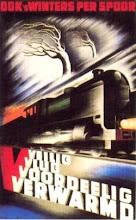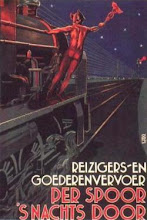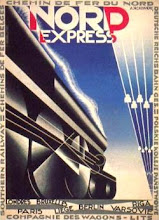Sunday, December 05, 2010
Lionel 289E running
Although it was already late and the light conditions poor, I did try to make a small video to show the Lionel 289E engine running. One of the last issues I faced with this engine were the smooth and slippery drive wheels. On many 027 curves and slopes the wheels just spun hopelessly. Some friends advised me to roughen the wheels. I tried by scratching the wheels, but still they spun on the track. Then I applied a 3 mm wide strip of duck tape on both the rear drive wheels and that seems to do the job.
Sunday, November 28, 2010
The new TCA-MG beer reefer


This week a beautiful beer reefer club car arrived, designed by the TCA member group and produced by Weaver model trains from Northhumberland PA. The beer brand is probably historic "Century beer made by the Schneider brewing company from Trinidad Colorado". The name of the brewing company suggests a traditional beer that is brewed according to the Reinheitsgebot and therefore is likely to be healthy.
Personally I like the pea-green colour, which is a truely old colour for an old reefer. The Weaver Alco FA-2 took it for a ride.
Tuesday, October 19, 2010
Lumber car

Autumn is well suited for trimming the trees and bushes in the garden. In my garden that yields substantial amounts of leaves and branches. Especially the oak, apricot and ahorn tree render nice straight side branches. I used some of them to fill the 50ft Weaver bulk head flat car. The bark was removed to speed the drying process up and reduce the chance of infestation. I will probably stain them a bit when they are fully dry.
Thursday, October 14, 2010
Lionel 289E ready to shine


After three coats of Tamiya TS38 gun metal the Lionel 289E engine shell was ready and beautiful. The two side number plates were too rusted to mount back on, so I used replacements from George Tebolt. The front L-symbol was kept original and also the the driving rods were polished and kept original. They are a slightly corroded, but then this lady is from 1937. The two red classification lights also came from George Tebolt. It is the first time in seventy years that this grey lady wears her classification lights again and they do look good.
Now it is time to sit back and enjoy the grey grace and let her run. Welcome back!
Sunday, September 19, 2010
Lionel 289E finally clean

The Lionel 289E is a heirloom item and so I waited a few years more than normal to remove the paint and get it repainted. The various paint layers where more difficult to remove than I previously had experienced. The top-layer was a hand-brushed thick layer of alkyd paint and underneath was the original gun-metal coating. I started with the conventional cooking pot method with old-fashioned near boiling soap-water. That removed most, but not all. Especially from the inside of the engine shell, hardly any paint was lost. People on internet-fora advised me not to sand-blast the item because of the fragile nature of die cast iron. So, I continued with carpet-glue-remover. This produced a thick gray gel of swollen paint that could be scraped off. Then I used the dremel and a brash brush attachment the remove the last paint residues. The cast iron shines and turns a bit dull in a few hours time. It behaves so different than tin-plate. Here is small picture of the shell ready for primer.
Wednesday, September 01, 2010
Veteranbanen




In the Eastern part of mainland Denmark runs an old steamer on old tracks. It is called veteranbanen (the veteran railroad) and runs between the villages of Bryrup and Vrads. The tracks run through a nice part of Denmark: lakes, hills and forest. On several days during the year a small steamer pulls the three wooden passenger-cars of an old motorised unit named Triangel back and forth between the two villages. The steamer runs very smooth and it is really a pleasure to make the trip.
Wednesday, July 28, 2010
S.T.A.R.


In the north of the Netherlands lies the longest stretch of rail that is being served by a museum railroad named S.T.A.R. short for Stadskanaal rail. One of the steam engines that runs most regularly is a Russified German steamer, the TE-5933. Built in 1943 in Germany and "left behind in Russia" and for some strange twist in history now in the north of the Netherlands. It is lovely restored and well running steamer and it was a joy to see it running.

It is a bit bizarre to see such a 'Russian' steamer in this part of the Netherlands with a long rooted communistic tradition. The red star kind of blend in nicely with the scenery. Fortunately that is all for the show now. This steam engine must have witnessed some of the blacker chapters of European recent history and that makes it even more bizarre to see it running by so smoothly.

Thursday, June 17, 2010
Kusan gondola kit

Yesterday, a KMT (Kris Model Trains) electric train kit for a Reading gondola arrived. Although clearly branded as KMT, the producing company is still listed as Kusan-Auburn in Nashville (TN). It was KMT # 0305:1.69. Although the kit is not dated, I think it should be from the early sixties of last century. A special advertisement was added for an "Atomic Train", which dates it before the seventies and makes it completely non-European.
The artwork of the box and of the instruction sheet is nice to see and hence I have added them. A memory of an old toy train brand and the cold war time gone by, when "atomic" was considered positive.
The gondola itself is fairly dirty and will need a wash. Especially the plastic wheels have picked up a thick layer of black stuff that will need to be removed. The scale of the gondola car is also surprising: it is larger than the underscaled 027 gondola's of Lionel, but also smaller than the zero scale gondola's of Lionel. Also interesting is the fact that the kit box is too small to accommodate the assembled gondola. So, that makes me double lucky to have find a complete gondola car with the original box and paperware.



Friday, April 16, 2010
Lionel 259T finished




Well it took me 2 slow years, but I got it done. The Lionel 259T tender is finished and it is time for a test ride with the 259E engine. The tender was purchased in October 2007 and when it arrived the corroded nature was obvious. Additionally, the handrails and two journal boxes missed. I completed the disassembly, rust removal and painting process already a year ago, but I struggled with the handrails. I wanted a freestyle restoration project with some self made handrails. Initially I choose brass 2-3 mm diameter brass pipes to solder these into the handrails. But they turned out to be too sturdy and nearly impossible to assemble correctly through both holes. I understood late that some flexibility would yield a better solution. It took a while before I saw the linchpins lying about at home and I got the idea. I drilled 1 mm holes through the linchpins head and stuck 1 mm pre-bended brass wire through it, soldered it and polished it. Well I am happy to have finished a pre-war car again. There are still too many neglected toy train cars waiting for some attention and care and I not sure yet which one will be next.
Sunday, March 21, 2010
Decapped MTH PCC Streetcar

A decapped MTH PCC streetcar was available locally for a sweet price. Since, this is unusual for MTH engines in Europe, I could not resist. The former owner wanted the cap only, to make his own Dutch 2-rail PCC streetcar. I tested the beheaded streetcar and all functions performed as they should do (bing bing and a lot of street car drivers small talk). Perhaps the battery is a bit low, so I will replace it with a freshly charged 9V Nimh. What to do with it? Hmmm. I still have the All Nation trailer box car kit, so it could be an idea to make an interurban traction engine out of it. A C&LE Red devil would be nice, with the only mishap that it did not pull trailers. Well, I will spend some time on finding an nice looking interurban engine that is suited.
A few weeks ago a nice looking Weaver NYRX reefer arrived here. Unfortunately the 702 coupler was broken. The reefer could move freely in the Weaver box and probably during rough handling it smashed into the sides and broke its coupler. The seller said that it sends me a replacement coupler, well probably by boat mail, so I glued the coupler for the time being.
Additionally, I finished painting my first railroad house. At first it was intended as a cover for some electrics, I think it worked out great. And it is good to have something finished again.
Sunday, January 10, 2010
TCA MG Club car 2009 and a roof finished


The TCA-MG club car was late in 2009. But it did arrive in the holiday season and here is it. It is a brown cattle car with nice detail. The doors can not be opened. But then again who wants steers running loose on the layout. The high resolution print details are remarkable and in general more then I can observe myself with my glasses.
During the last months I spend most of my time glueing slates on the roof of the house that I am scratch building. It was a tedious and rewarding process. In the summer we bought a binder with plastic clamp rings. Basically, you put a whole bunch of papers in, it perforates the papers and presses a plastic clamp through. Since, you do not have to feed the perforator with a clamp and it yields more then 20 pieces of paper of roughly 2 x 7 mm (about 1 x 3 milli-inch) it is an easy way of getting lots of roof slates in one stroke. I used fairly thick brown cardboard to get more 3D-structure in the roof and personally, I like the result. The house is one step further to completion. Now, I still have to get drainage pipes, a veranda roof and start painting. Yes, the roof will need a slate grey colour as well, but that is for later concern. Several visitors told me that they liked the result, but that I should better focus on other restoring the many railroad cars that are still waiting. Well, honestly, I liked this monk work. Not so much that I will ever turn into a rivet counter, but it yields a positive feeling reward. What else do we want in this "crisus".
Friday, November 27, 2009
Hoppers


This week a really nice "Golden loaf" flour hopper arrived. So, it is time for a test ride and a line up with all the other hoppers. This PS-2 Weaver hopper was available local and for some reason most European zero-scale modellers still do not appreciate the quality of Weaver cars, so I got it for a bargain. And because hoppers seldomly ride single, it is nice to have it here.
On the web, there is even a photo of the original hopper and although the original was shaped a bit differently, I do not mind Weaver to have improved the overall appearrance. Furthermore, this hopper was the Weaver club car of 2008. So without being an official member, the hopper is here to stay.
Tuesday, September 29, 2009
MTH Camelback running
This weekend I succeeded in making some good shots from the new MTH Camelback. Moreover, I also managed to blow the whistle button this time. In order to prevent the fire alarm from kicking in, the total time smoking was kept minimal, nevertheless it did smoke!
Tuesday, September 22, 2009
MTH Camelback

Today, a beautiful present arrived: a MTH Camelback engine with Protosound 1, #30-1142-1 from Reading railroad. Just look at it. Soon you will be able to hear its puffing and chuffing as well. The battery was a bit low, so the engine is now powered in neutral to charge itself and meanwhile it blows off steam. The green classification lights are lit as well.
Camelbacks are truely American hazardous steam engines, a unique design in many ways.
I choose this engine, since it very close to scale, has the protosound options that also function with European (230 V, 50 Hz) current, is a Reading engine and negociates the curves of 027 layout without issues.
The engine was purchased at Grzyboski trains. Just want to thank them for their service, charging realistic shipping costs and friendly assistance.
Sunday, August 02, 2009
new additions


A few days ago some new Weaver Union Pacific cars joined my little layout. A crisp lettered boxcar with "bolster snubber springs" and a 40 foot tank car. The box car runs good on the 027 curves, the tank car required two spacer rings to elevate it a few millimeters and get it correctly through the 027 curves.
Wednesday, June 03, 2009
Weaver alco on 027 tracks
Thursday, May 14, 2009
Lionel 1677

Today, a beautiful pre-war gondola arrived. It is the green Lionel 1677 that was produced from 1933-1935. A long lithographed car that was part of entry level start sets of that time. Some other cars of the same serie, like the 1679 Baby ruth box cars, the 1680 Sunoco and Shell tank cars and 1682 Caboose were much more common. The only exception is the truely rare 1678 Stock car of the same serie. Personally this green gondola is a outstanding beauty.
Sunday, March 01, 2009
Alco running
Although the new FA-2 diesel engine doesnot have QSI, Protosound, Trainsound or whatever fancy hightech sound system, it does have an unique motor sound. Probably caused by the chain drive. Listen to the video and perhaps watch as well.
Weaver UP Alco #6540



About a month ago, I received a beautiful Weaver FA-2 Alco diesel engine in Union Pacific livery from Northern Saskatchewan. Although produced in 1990, the windows and horns were still not glued on yet. After it stood on the tracks and received some AC-current the lights lit up and the motor made a snorring sound, b
 ut the engine did not move.
ut the engine did not move.

After dissembling the hood, a missing gear wheel was directly
 appearent. After inspecting the box a small fragment of a plastic gear wheel was found.
appearent. After inspecting the box a small fragment of a plastic gear wheel was found.Based on this fragment a new 8-teeth gear wheel from brass was made by drilling a center 4 mm hole. Then a circle was drawn on 3 mm distance of the hole with a ring and with high-school triangle 4 lines through the center and 45 degrees apart where drawn. On the eight positions where the circle crossed the line small 1.5 mm holes were drilled and afterwards the rough gear wheel was cut out of the brass plate. After sanding and soldering and sanding, the new gear wheel was mounted on the main drive rod, but unfortunately the motor did not run good. The chain tension was too high and consequently the torsion was too high.
In order to reduce the chain tension 1 mm was sanded from the plastic positioning plate for both main drive rods. The mounting holes for this plate were enlarged and after re-assembly the chain could move much more easily. The a special spacer was made from a K&S brass pipe of 4 mm internal diameter and 3 mm width. This helped to position the upper gear wheel precisly over the bottom gear wheel.
Now it finely runs! I must acknowledge my local Lionel train friend for giving me the
 repair suggestions that
repair suggestions that  proved to be the right ones. The engine runs on my 027 layout, but does not like the Lionel 027 switches, because it touches the switch-house with the lower middle hood when it runs over the curved track of the switch. Furthermore, the couplers can not remain centered on 027 track, meaning that they will derail the first car connected in a 027 curve. This can be circumvented with a elastic rubber band over the open couplers, but it is not nice. What is nice of this engine is complete skirt: and not two single parts where the light shine through.
proved to be the right ones. The engine runs on my 027 layout, but does not like the Lionel 027 switches, because it touches the switch-house with the lower middle hood when it runs over the curved track of the switch. Furthermore, the couplers can not remain centered on 027 track, meaning that they will derail the first car connected in a 027 curve. This can be circumvented with a elastic rubber band over the open couplers, but it is not nice. What is nice of this engine is complete skirt: and not two single parts where the light shine through.
Monday, February 09, 2009
P&LE Boxcar


A beautiful Weaver PS-1 boxcar has joined us. It is a jade green NYC system Pittsburgh and Lake Erie boxcar made in a special run for P&D hobby. The doors can slide open, but sufficient force needs to applied to get them moving. A well-detailled little treasure train car that emerged locally. What a small fortune indeed. This boxcar was already suited for 3-rail operation and hence does not need to be converted to the right amount of rails.
Subscribe to:
Posts (Atom)







